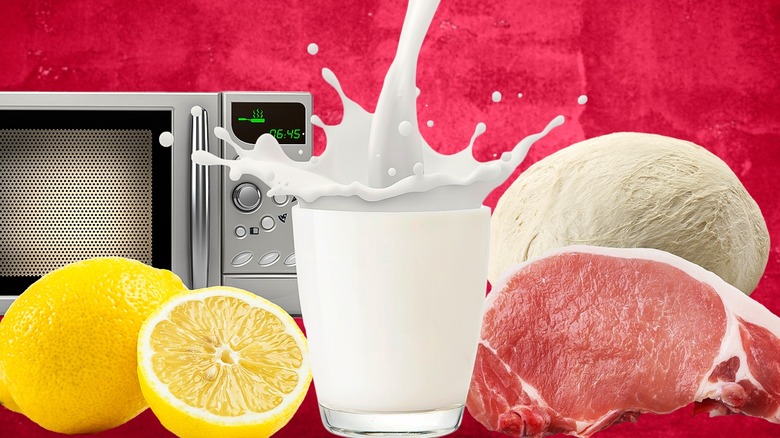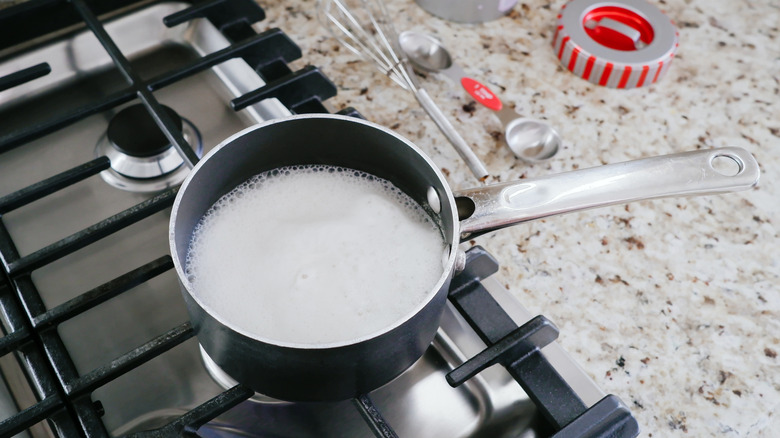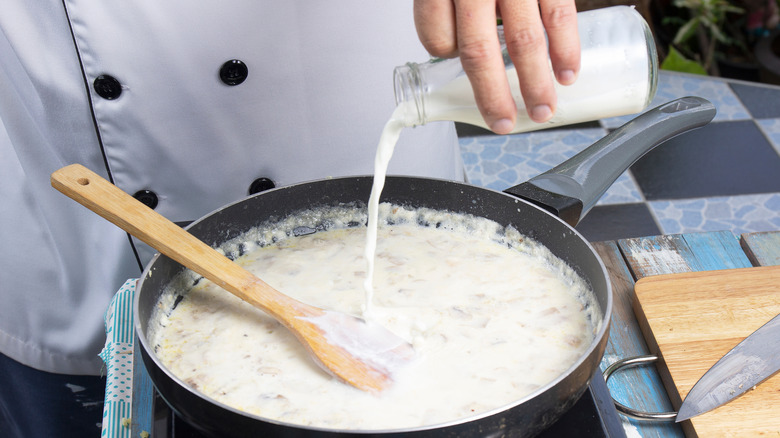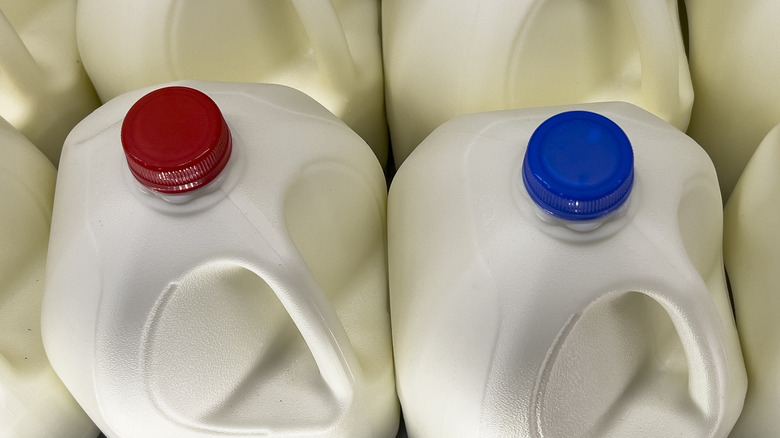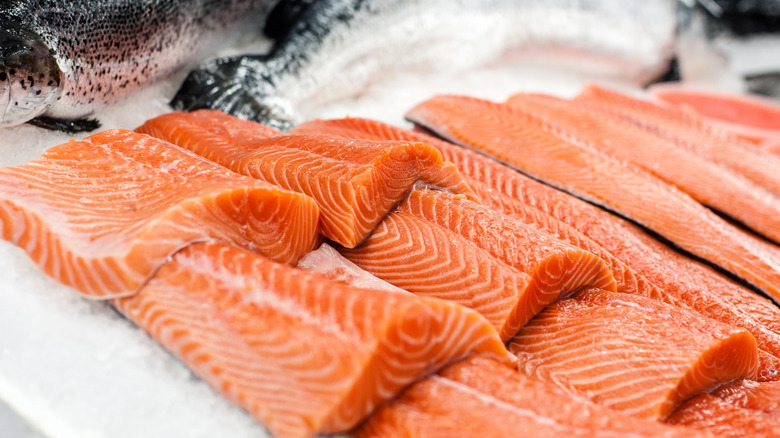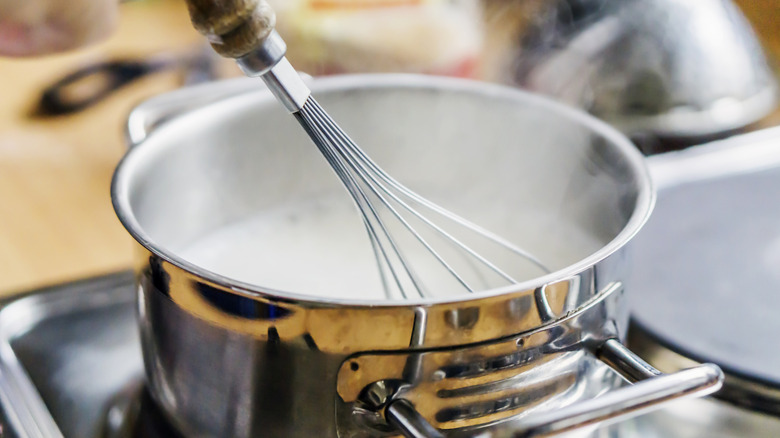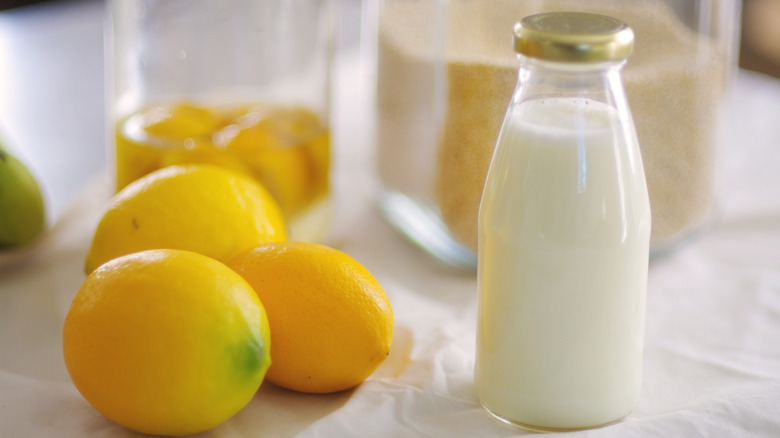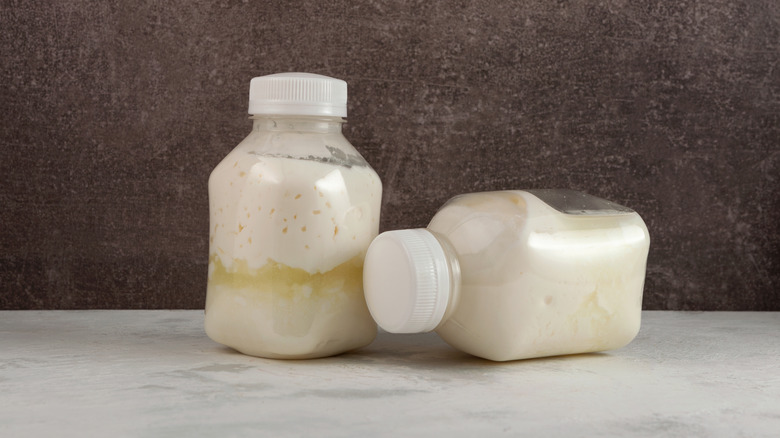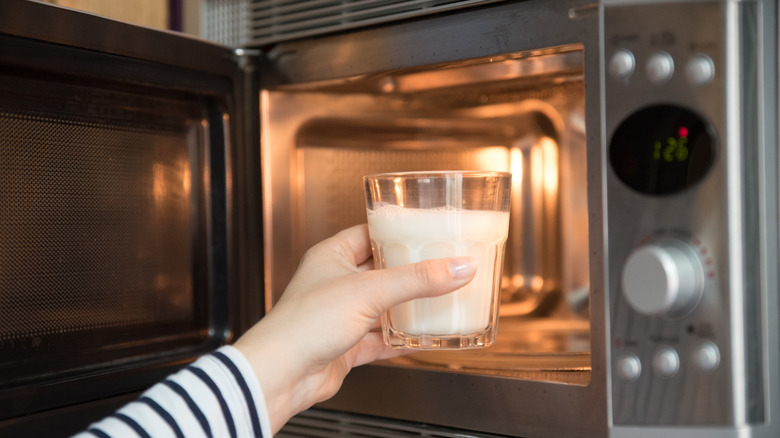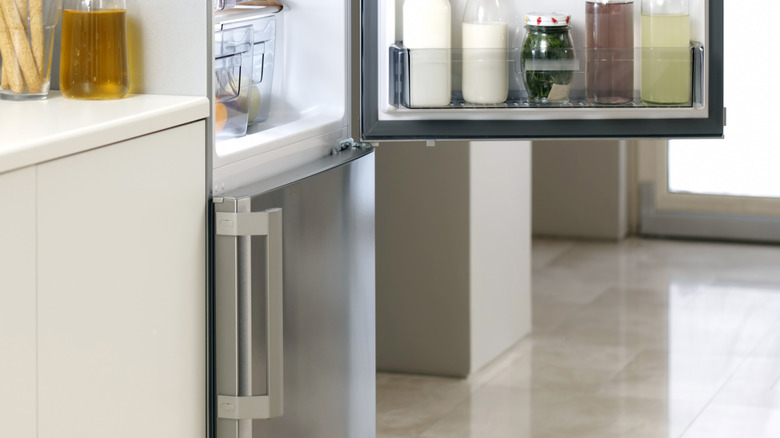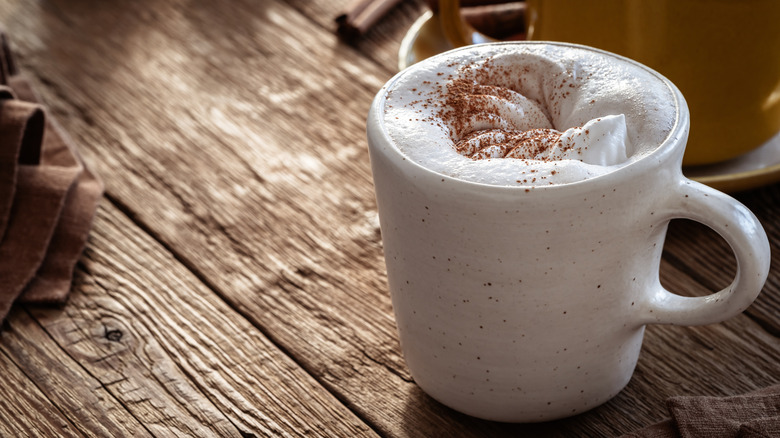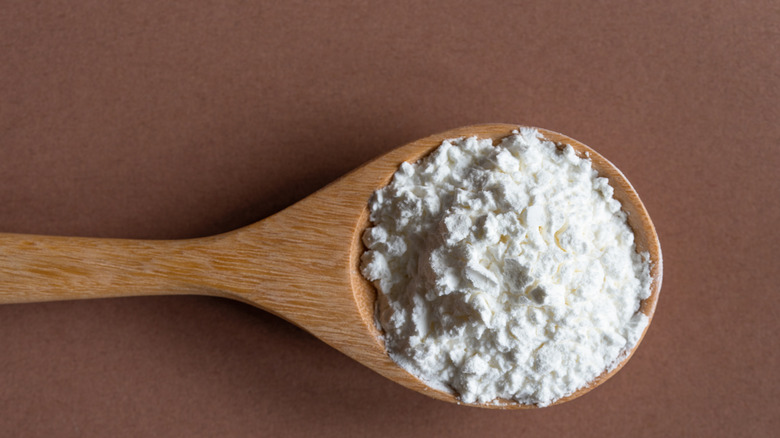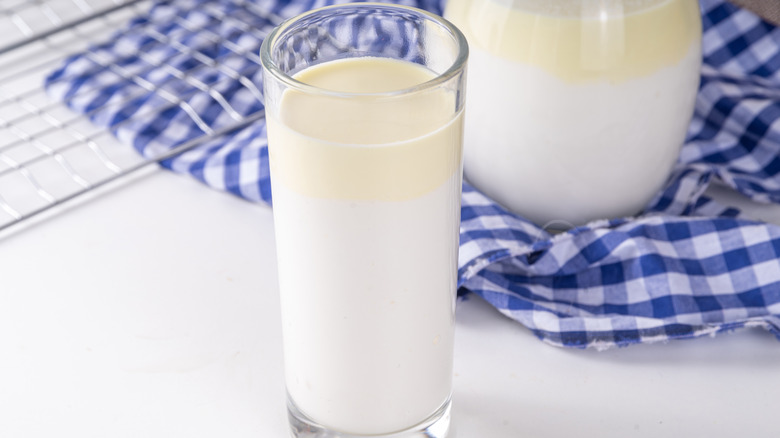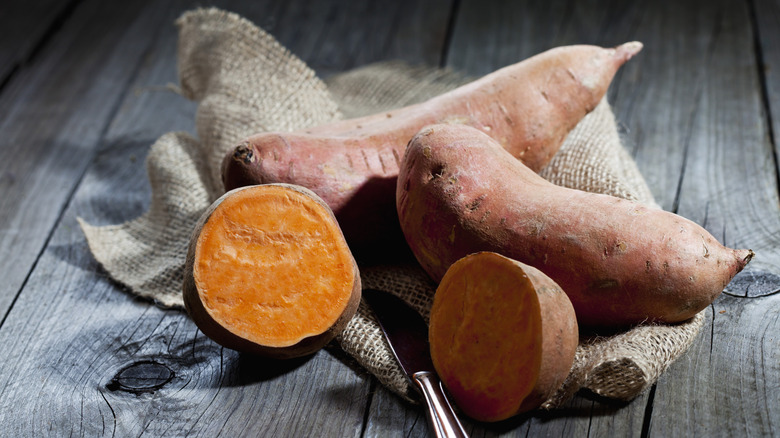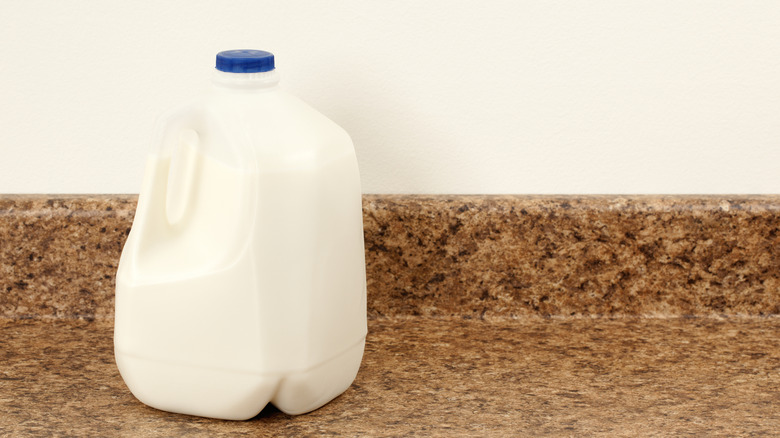14 Mistakes Everyone Makes When Cooking With Milk
If there's one ingredient in the kitchen that will have you kicking yourself for not paying attention in chemistry class, it's milk. While chemistry jargon like proteins and pH might not be in your everyday vocabulary, they are often the culprits for why your milk-based recipe didn't turn out quite right. Luckily, you don't need an equation to fix your problem. You just might need to change your technique.
If you want to understand why certain problems are happening while cooking with milk, it might help to know that milk is made up of water, protein, fat, carbohydrates, vitamins, and minerals — properties that can change when heat and acid are added. While sometimes there are ways to mask the effects of a milk-cooking mistake, a lot of times, the damage is irreversible.
Sometimes, the biggest mistake in the kitchen is not using an ingredient to its full potential. In this case, milk has many surprising uses in cooking, such as marinating and braising. A lot of factors come into play when cooking with milk. Cooking experts Fanila Nawaby, chef and owner of Mimi's Kabob, and Ken Tobby, CEO at Organic Solace, shared some of the mistakes they most often see in the kitchen. Here is a list of their insights, along with other cooking mistakes commonly made when cooking with milk.
You cooked it on too high of heat
It can be a major time saver to turn the dial all the way to "high" and wait for your milk to heat. However, this shortcut might not work the way you want it to when it comes to milk — after all, it will take much more time to have to throw away scorched milk and start from scratch.
Fanila Nawaby shared that the best way to heat milk is to cook it "slowly over medium-low heat while stirring frequently to prevent burning and ensure even cooking." If you end up burning your milk, Nawaby advises that the best thing to do usually is to throw it out since the flavor will change for the worse.
Not only will the flavor change, but high heat can also affect its consistency. When milk is cooked on too high of heat, it can curdle. In curdled milk, you will often find mysterious chunks floating around. These chunks are the result of the milk's proteins clumping together after the pH was altered.
If you are drinking milk to fulfill your daily vitamins, you might not want to boil your milk because it will have lower nutrients than just drinking it cold from the fridge. Notably, when you boil milk, you are also lowering its B vitamin and folic acid content.
You added cold milk too quickly
Imagine you are on one of the final steps of your soup recipe and it calls for milk. Without thinking anything of it, you take milk out of your fridge and pour it directly into your hot soup mixture that you have already worked so hard on. You might be up for a rude awakening when you stir in your milk and notice that there are suddenly new chunks in it. This is because your cold milk curdled when you poured it into the hot mixture.
You might notice this happens more often when you are making your morning coffee and your milk curdles in your mug. Essentially, you are rapidly heating up your milk and the temperature change triggers the curdles.
Fanila Nawaby said it is hard to fix a dish once your milk has curdled. You can get some of the chunks out with a strainer, but that will only do so much — likely still leaving you with an unpleasant consistency. Nawaby said the best way to avoid this from happening is to "always temper the milk." To temper the milk, all you have to do is warm it up a little bit before dumping it into your pan. This way, it won't be such a dramatic temperature change, and you will be able to protect the delicate texture of your soup.
You used the wrong kind of milk
While most milks look and taste similar, the fat content is important to pay attention to when purchasing for a recipe. It is possible to use milk that has too much fat, as well as one that does not have enough fat.
Fanila Nawaby said, "Some may opt for low-fat milk for health reasons, but certain recipes require the fat content in whole milk for proper texture." If you are cooking a dish and realize you used the wrong milk, Nawaby said you can try to fix this issue by adding butter or cream to thicken the consistency.
On the other side, Ken Tobby shared that sometimes too much fat in milk can cause issues with your dish. "Although full-fat milk adds richness, an excessive amount of fat can overpower a meal and give it an oily feel rather than the desirable creaminess," he said. To avoid this, he said, "Measure and balance the fat in your recipe carefully, and if necessary, think about using lower-fat milk."
You aren't using it to soak meat and fish
If you realize the piece of fish or meat has a strong odor to it — and you are certain it is not because it has gone bad — then you can try soaking it in milk to get rid of the smell. This also works for taking away some of the gamey taste of certain meat, such as venison.
Marinating fish and meat in milk might seem strange, especially since they aren't often paired together, but you are missing out if you don't try it. All you have to do is soak your protein for a certain amount of time (depending on what kind of protein it is) and then rinse it off. Hopefully, you will be left with a fresh and less fragrant piece of meat or fish.
This works because milk is made up of whey and casein proteins — the latter is the one responsible for its neutralizing effect of stinky fish and meat. By binding to the components causing the odor, the casein proteins do a good job of eliminating most of the unpleasantness.
You didn't stir it enough
Milk is not something you can just leave on the stovetop to cook while you step away to do dishes. While it would be convenient to not have to constantly attend to, milk is fairly needy and requires lots of attention. If you aren't stirring it enough, it might burn.
This is because milk contains sugar, which easily burns if left sitting still in the pan for too long. When you stir it, you are moving the sugars and other particles around so that they are not sitting in one place for too long and risk burning.
Fanila Nawaby said the proper technique of cooking milk is regularly stirring to make sure it does not settle at the bottom of the pan and burn. Similar to other mistakes that lead to burnt milk, it's hard to fix burnt milk so it's best to throw it away and start fresh.
You paired it with the wrong ingredients
One mistake that might fill you with regrets later on is combining the wrong ingredients with milk. While seemingly a cooking neutral, milk does not necessarily go with everything. However, this is not just because of the taste factor. There are certain ingredients that, when combined with milk, have been known to cause digestive issues.
Ken Tobby noted that fermented food, citrus fruit, salty food, and fish are all examples of dishes that should not be combined with milk. Food with high acidic levels, such as citrus and fermented foods, are considered a no-no since it can cause a stomach ache in some people. Curdling is also an issue when it comes to milk and acidic food. When acid is added to milk, it has a similar effect to when heat is added. It creates a reaction and clumps form.
Salt might be a surprising one to some people because it is not an ingredient you might think to add to milk. However, that is probably a good thing because Tobby said combining salt and milk can "slow down digestion."
You threw away sour milk
While it is disappointing to see that your milk has expired, it doesn't necessarily mean the milk is at the end of its life. By not tossing sour milk, you can limit waste and end up making something delicious.
Note that there is a difference between sour milk and spoiled milk. Sour milk might be past the expiration date, but it's not going to have a strong foul odor or taste. It also shouldn't have chunks floating in it. If it does, then that's spoiled milk and it would be a whole other mistake to not dispose of that.
But if it's just slightly sour, then there is no reason to throw it away just yet. There are a lot of different recipes that lend itself well to sour milk. It is common for sour milk to be used in baked goods. It is also a great substitute for buttermilk in pancakes, waffles, and more.
You aren't using the microwave
Since cooking milk can be such a delicate process, it seems only logical to pull out the fancy cookware and set it on the stove burner. There's something about stirring a pot of something on the stove rather than in the microwave that makes it feel much more culinarily correct. However, that is not always the case, as it can be more difficult and oftentimes unnecessary.
If you opt for the microwave the next time you need to heat up milk, there are a few precautions you should keep in mind. The most important thing is to make sure the bowl or container you are heating the milk up in is microwave-safe. If you are unsure if your vessel is microwave-safe, this is usually indicated on the packaging or on the bottom of the container. Remember you should never put metal in the microwave since it can cause sparks and fire.
After you find a safe container for your milk, you can put it in the microwave and set it to medium-high. While the microwave is easier in some aspects, you are still going to have to regularly stir it in increments so it does not burn.
You are storing it wrong in the refrigerator
No matter how big a refrigerator is, it always seems to fill up as groceries, condiments, and leftovers accumulate. Sometimes, the only shelf your gallon of milk fits on is the one on the door. Unfortunately, this is not the best place to store milk
According to the FDA, milk should be stored no warmer than 40 F or 4 C. To maintain the taste, consistency, and safety of milk, it is important to pay attention to how you are storing your milk. Ken Tobby said, "If stored improperly, bacteria can proliferate, causing spoilage."
Tobby said it is best for milk to be stored in "the coldest section of the refrigerator." Naturally, the back of the refrigerator remains the coldest part as it is the least affected by the warmth introduced when the doors are opened. This would make the door the worst place to store milk because when you open the door, it is exposed to a drastic change in temperature.
You're not using it to substitute water
One of milk's greatest assets is its creaminess. If you are looking to make something with a creamy texture, dairy products are usually the go-to. However, sometimes recipes call for either milk or water. A lot of this is based on preference, but adding milk will likely give your dish a rich and creamy touch that water would not be able to provide. In addition to improving consistency, milk also has more flavor than water so it can be used to add depth while cooking.
Even if a recipe calls for water — depending on the compatibility with the rest of the ingredients — you can substitute milk to make it your own. Many boxed cake mixes call for water, but you can swap the water out for the same amount of milk to enhance the texture and flavor. Other things you can swap water out for milk are hot chocolate and oatmeal. In both cases, the version made with milk is going to be much creamier than if it was made with water.
You didn't dissolve your starch first
A common issue with recipes that call for milk is that they turn out grainy. In order to thicken your dish, a recipe might call for a thickening agent. These are typically starches such as flour and cornstarch. While these ingredients can be effective, you might find clumps in your dish if the starches are not properly dissolved.
Ken Tobby said the best way to ensure a smooth consistency after adding the starch is to dissolve it in a cold liquid before adding it to the main dish. He said, "In this case, the key is to gradually incorporate and whisk it to perfection."
When you mix cold water with a starch such as cornstarch, it is called a slurry. Once your slurry is completely dissolved, then you can add it to a hot mixture without running the high risk of clumps forming. While using this method, make sure you are still taking precautions to not burn or curdle the milk.
You are using unpasteurized milk
Make sure the milk you are using is pasteurized before you consume it. The pasteurization process consists of raw milk being heated to a certain temperature to kill off dangerous bacteria. The CDC considers unpasteurized milk "a serious health risk."
Consuming raw milk is especially dangerous for people with weakened immune systems, children, teenagers, older adults, and pregnant women. Examples of foodborne illnesses that can be caused by drinking unpasteurized milk are listeria, salmonella, and brucella.
Even though the milk is being heated, the CDC states that pasteurized milk is just as nutritious as unpasteurized. This is because the nutrients in milk lower when it's boiled; however, milk does not reach the boiling point when it is pasteurized.
It is possible to pasteurize your milk at home, but it is a delicate process that might be best left to the professionals if you have the means to buy pasteurized milk. To avoid buying unpasteurized milk, make sure to always check the label.
You don't use milk for braising
If you are using some form of broth, beer, or wine to braise, you are missing out on the magic that can happen when you try to braise meat or vegetables in milk. Braising is the process of searing something before being cooked low and slow in some form of liquid. The goal of braising is to create a tender and flavorful dish, a job in which milk excels.
When milk is used as a braising liquid, it tenderizes the meat or vegetables being cooked and creates a creamy sauce to go along with it. This method goes back to the 17th century and the reason it works so well is — yet again — based on science. Milk contains lactic acid, which tenderizes the meat or vegetables.
You can braise a variety of different things. For example, sweet potatoes are delicious in milk-braised dishes. The milk will soften the potatoes and enhance their flavor.
You let it sit out too long on the counter
When you are cooking, it's easy to wear yourself out before you get a chance to clean up the mess. There's nothing wrong with letting a couple of dishes sit, but what you don't want to do is leave your milk out on the counter for an extended period of time.
Unless you keep your house under 40 degrees Fahrenheit, it's not safe to drink milk after it's been left out too long. Once milk has been on the counter for two hours, it's officially considered in the danger zone by the USDA. If your house is over 90 degrees Fahrenheit, it's only safe to drink for an hour before it goes bad. Once it's reached the danger zone, bacteria will rapidly grow — even if it's been pasteurized. If you want to avoid waste, make sure you are adamant about keeping your milk out of the danger zone and in the fridge.
